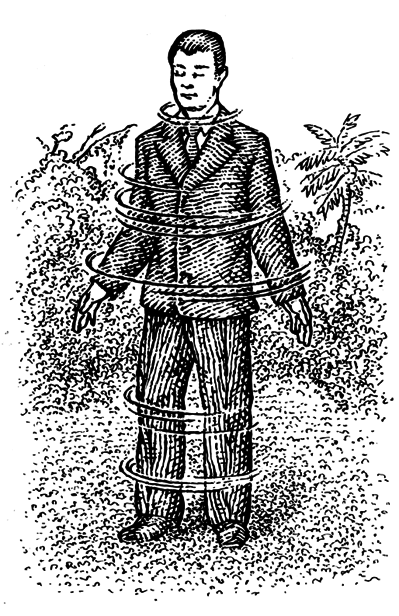A Field Guide to Lucid Dreaming (17 page)
Read A Field Guide to Lucid Dreaming Online
Authors: Dylan Tuccillo,Jared Zeizel,Thomas Peisel

Naps can be a really effective way to perform a wake-back-to-bed as well.
During naps, our bodies are tired but our minds are relatively more awake than
in normal sleep. Some nappers fall right into REM or start dreaming soon after
they fall asleep, so your chances of a lucid dream are pretty good. Much more
research needs to be done in this area, but experts suggest to nap for twenty
minutes, forty minutes, or ninety minutes.
Quite often, the amateur lucid dreamer’s early exploits in
lucidity last only a few moments. If you’ve become lucid already
but lost your awareness very quickly, don’t
worry. This is common. In the next
chapter we’ll look at ways in which you
can stabilize the dream and stay lucid
for long stretches of time. And if you
haven’t become lucid yet, do not fret.
There’s plenty of time to practice.
=
106
<
After Aldrin and Armstrong’s lunar module landed, they were
supposed to sleep for five hours before leaving the cabin and ven-
turing out onto the surface of the moon—they’d been awake for
a while after all. The astronauts ignored this plan and left as soon
as possible. They were just too excited to sleep. Wouldn’t you
be? Charles Conrad Jr. was the third man to step on the moon.
“Whoopee!” he said. “Man, that may have been a small one for
Neil, but that’s a long one for me!” We know just how he feels.
�
Summary
• The most common way to have a lucid dream is to become
aware during a regular dream.
• The most effective way to accomplish this involves performing
the waking techniques that trigger awareness such as reality
checks, finding dream signs, and setting intentions to become
lucid before bed.
• To maximize results, catch the last (or second to last) REM cycle
by waking up six hours after you go to sleep and then going
back to bed.
• Before going back to bed, stay up for fifteen to twenty minutes
and get your brain active. Go to sleep with the intention of
becoming lucid, seeing a dream sign, or performing a reality
check.
=
107
<
10
Staying Lucid
<•=
I soon realized that no journey carries one far unless, as it extends into the
world around us, it goes an equal distance into the world within.
—Lillian Smith,
author, social critic, and notorious fighter for equal rights
The small boat bobs in the ocean, thrown around by
waves. You jump off the lip of the boat and hit the water.
With a kick of your flipper, you find yourself engulfed
by the blue ocean. The protective casing of your scuba mask grants
you sights of exotic coral and fish. Ten seconds go by, and nor-
mally that’d mean time to surface; that small breath of oxygen
in your lungs would be depleting. But fortunately, there’s an O2
tank strapped to your back and a hose leading to your mouth. As
a scuba diver, you can swim underneath the waves for a long while
without worry. A pink cloud floats by, tiny speckles of plankton,
and you swim. You’re free to search for strange fish, crustaceans,
and whales. You’ve got all the time in the world.
=
109
<
Most lucid dreamers would agree: there’s nothing more frustrat-
ing than getting lucid and losing your awareness shortly thereafter.
As lucid dreamer Dominic O. explains, “It felt like I had
woken up and I immediately decided to start messing with things.
I acted out my fantasies of doing and saying whatever I want, but
holding on to that awareness was too difficult to last more than a
few minutes in the dream. Instead of lapsing back into being un-
lucid, I woke up.”
Whether you wake yourself up out of excitement or sink back
into an unconscious dream, awareness doesn’t always stick once
you find it. It requires a delicate balance. The ability to remain
lucid is a skill that every lucid dreamer must learn if they want to
explore the dream world.
We know it can be exciting. Throughout the day you ask your-
self, “Am I dreaming?” with an obvious “No.” The moment the
answer becomes an astounding “YES!” you feel a tremendous rush
of emotions. This excitement causes many beginners to wake them-
selves up, back in their bedroom again. No need to feel bad about
it. It happens to the best of us, and there’s always tomorrow night.
For other dreamers, the problem may be more subtle. In the
waking world, we might get so engrossed in a TV show that we
forget about the popcorn that’s been in the microwave for fif-
teen minutes. A similar bad habit often occurs when you’re lucid.
Getting lost in whatever dream activity you’re doing can be con-
suming and before you know it, you’re back to having a regular ol’
dream. In order to master lucid dreaming, you must stay balanced
with one foot in the dream and one foot out. In other words,
engage the dream but never forget that you’re dreaming.
=
110
<
To hold on to that self-awareness, get in the habit of anchoring
yourself in the dream. To anchor, simply stop what you’re doing
and perform a technique that sharpens your focus. The result is
a stable dream environment that you can explore freely and for
longer periods of time. Learning how to prolong your lucidity is
like having a tank of oxygen when diving. With it, you can explore
the ocean for much longer. Instead of skimming the surface, your
tank allows you to travel deep into the sea, down to the ocean floor
where the real treasures of your subconscious are hiding.
When to Anchor Your Dream
1. Upon becoming lucid.
The first moments of a lucid dream are
the most crucial, so perform these stabilizing techniques directly
after becoming lucid. Before jumping into your dream adventure,
always pause for a second and anchor yourself in the dream by
performing the techniques at the end of this chapter. If you’re too
hasty, you won’t go very far anyhow.
2. When the dream starts fading.
When the lucid dream is in
danger of becoming a normal dream again, you’ll actually see it
happen. As your lucid dreaming abilities progress, you’ll notice
that the first of your five senses to go is often sight. Visual elements
begin to fade and corrode. As if you stood up too quickly from a
chair, the world in front of you will blur and darken. We have a
big, fancy, incredibly hard-to-pronounce word for this phenom-
enon: fading. If the dream begins getting fuzzy or lacks richness,
you’ll know you’re fading and that it’s time to stabilize.
=
111
<
3. To amp up lucidity.
Most important, these techniques will allow you to heighten your level of awareness. Even if your lucid dream
isn’t at risk of ending, it’s possible for your awareness to lessen.
Awareness is not a binary switch, on or off. It lies on a spectrum
from “zombie” to “Buddha” and everything in between.
Stabilization Techniques
The techniques below work in any of the three situations:
whether you’ve just become lucid, are starting to fade, or
want to amp up your awareness. Pick the few that work best for
you and have fun mixing and matching various techniques.
keep calm and carry On
Lucidity can be a very powerful and stimulating experience. But
like a feral horse, unless you control and tame your excitement it’ll
get away from you. We know, it’s hard to ignore the childlike voice
in your head telling you to celebrate. “Wahooo, I’m lucid!”
Put down your flute of champagne and hold off on the celebra-
tion until after you wake up. As soon as you get lucid, stay calm
and try to relax. Take a deep breath of dream air, look around, and
instead of complimenting yourself on being such a whiz, take it
slow. Once you’re calm you can begin exploring.
Spinning
Try this technique, which was introduced by Stephen LaBerge. He
was searching for a way to prolong his lucidity during his research
and stumbled upon this highly effective approach. The idea is very
=
112
<

=
113
<


simple. To stabilize the dream, spin yourself (your dream body)
around like you’re doing a pirouette.
You don’t need to be a master ballerina, simply turn yourself
in a clockwise or counterclockwise direction. Dr. LaBerge notes
that information on balance and movement are closely related with
visual information. The sensory experience of spinning will pro-
duce a stable picture of the world around you, and it will make it
difficult for your mind to communicate with your physical, sleep-
ing body, which could wake you up.
Stay Engaged
I found myself in my parents’ house down-
You’re in a dream—don’t
stairs. The thought crossed my mind that
just stand there, begin your
I must be dreaming, so I tested it out by
adventure! The passive
attempting to fly toward the sliding glass
dreamer will soon find him-
door. I could fly and instantly became
self forgetting that he’s in a
lucid. Feeling a bit unstable, I quickly
dream. You don’t have to go
focused my attention on the sliding glass
crazy, just find a tactile way
door. I pushed my leg through it and felt
the coldness it produced. It was like put-
to interact with your sur-
ting my leg through a streaming waterfall
roundings. Dr. LaBerge has
of ice. The sensation intrigued me and I
a lot of experience with this
walked around feeling what other things
pesky problem and advises
felt like in the dream world. —SaM O. T.
us to load our perceptual
system so it cannot change
its focus from the dream world to the waking world. Because you’ll
always have them at your disposal, try concentrating on your own
hands. Look at them, really examine them. Focus on something
and stay active— it will always help to stabilize the dream.
=
114
<
Strike a Balance
While it’s important to stay engaged in the dream, don’t get too
wrapped up in one thing for too long. You might forget that you’re
